UNIT 2
Key Management and Distribution
UNIT 2 - Key Management and Distribution
- Symmetric Key Distribution Using Symmetric Encryption
- Symmetric Key Distribution Using Asymmetric Encryption
- Distribution of Public Keys
- X.509 Certificates
- Public Key Infrastructure
Key Management and Distribution
##[fit] Key Management and Distribution
Key distribution is the function that delivers a key to two parties who wish to exchange secure encrypted data. Some sort of mechanism or protocol is needed to provide for the secure distribution of keys.
Public-key encryption schemes are secure only if the authenticity of the public key is assured. A public-key certificate scheme provides the necessary security.
X.509 defines the format for public-key certificates. This format is widely used in a variety of applications.
A public-key infrastructure (PKI) is defined as the set of hardware, software, people, policies, and procedures needed to create, manage, store, distribute, and revoke digital certificates based on asymmetric cryptography.
Typically, PKI implementations make use of X.509 certificates.
How to share the Key ?
4 Ways to share keys
- A can select a key and physically deliver it to B.
- A third party can select the key and physically deliver it to A and B.
- If A and B have previously and recently used a key, one party can transmit the new key to the other, encrypted using the old key.
- If A and B each has an encrypted connection to a third party C, C can deliver a key on the encrypted links to A and B.
Factors affecting End-to-end encryption
-
No. of Hosts at IP level If N no of hosts then the no of keys required is [N(N-1)]/2
-
No of Hosts and processes at Application Level
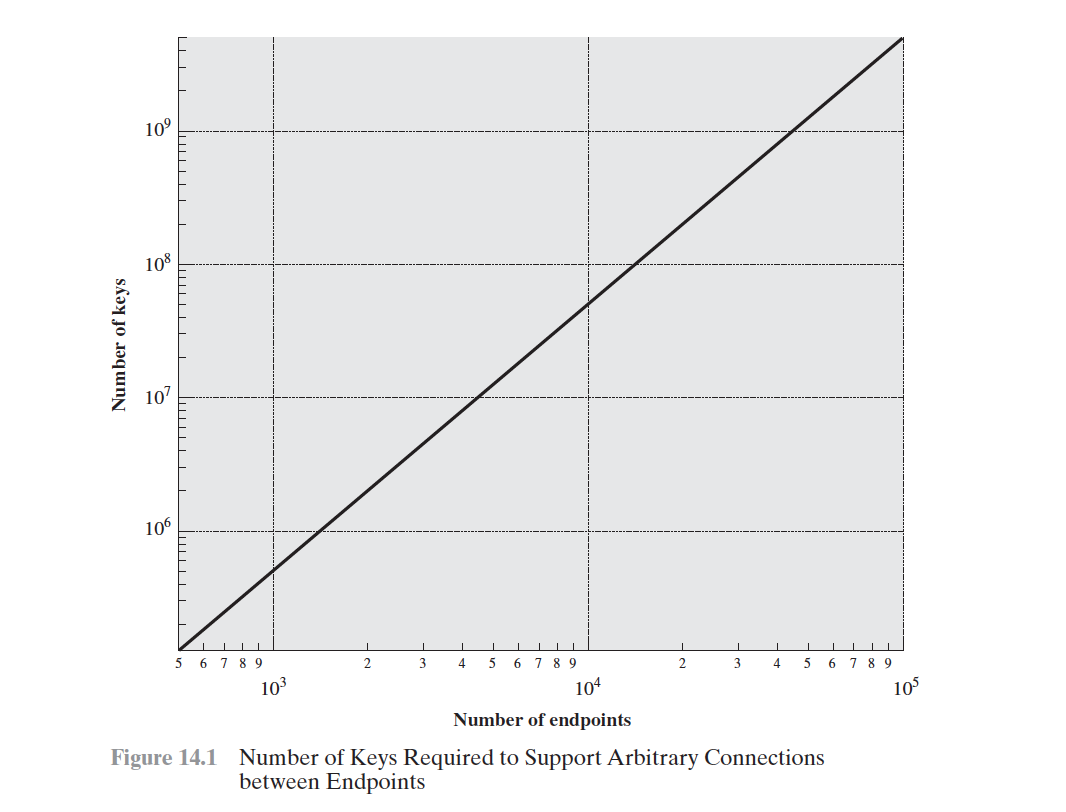
Key Distribution Scenario
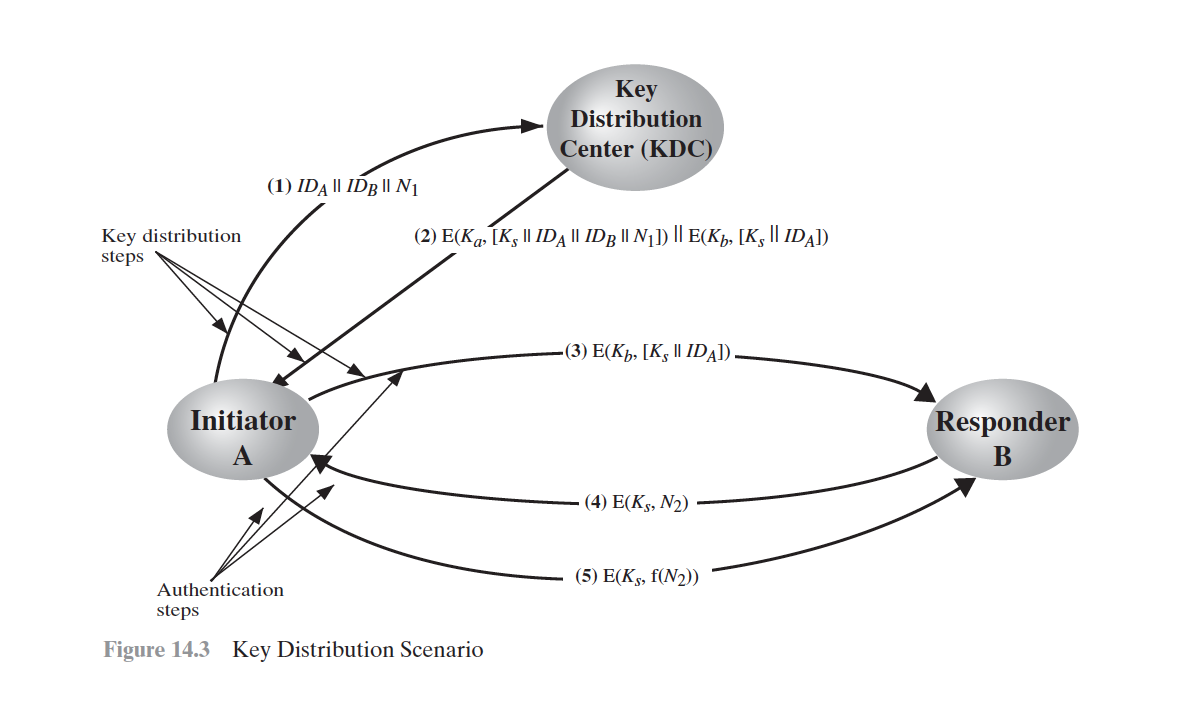

Assumptions
- Let us assume that user A wishes to establish a logical connection with B and requires a one-time session key to protect the data transmitted over the connection.
- A has a master key, Ka , known only to itself and the KDC; similarly, B shares the master key Kb with the KDC.
Steps Overview
Step 1
A sends areques to IDa || IDb || N1 to KDC where IDa -> Identitiy of A IDb -> Identitiy of B N1 -> Unique Identifier (Nonce)
Step 2
KDC Responds back with a message encrypted with Ka
-
Message Intended for A Ks -> One time session key Original Message Sent by A
-
Message Intended for B Ks -> One time session key IDa -> An identifier of A
-
Message for B is encrypted with Kb
Step 3
A sends the message intended for B sent by KDC E(Kb, [Ks || IDa]) Kb -> Master key of B Ks -> Session Key IDa -> Unique Identifier of A
Step 4
Using the newly minted session key for encryption, B sends a nonce, N2, to A.
Step 5
Using Ks,A responds with f(N2), where f is a function that performs some transformation on N2.
Steps Detail
-
A issues a request to the KDC for a session key to protect a logical connection to B.The message includes the identity of A and B and a unique identifier, N1, for this transaction, which we refer to as a nonce. The nonce may be a timestamp, a counter, or a random number; the minimum requirement is that it differs with each request. Also, to prevent masquerade, it should be difficult for an opponent to guess the nonce.Thus, a random number is a good choice for a nonce.
-
The KDC responds with a message encrypted using Ka. Thus,A is the only one who can successfully read the message, and A knows that it originated at the KDC.The message includes two items intended for A: • The one-time session key Ks, , to be used for the session • The original request message, including the nonce, to enable A to match this response with the appropriate request Thus,A can verify that its original request was not altered before reception by the KDC and, because of the nonce, that this is not a replay of some previous request. In addition, the message includes two items intended for B: • The one-time session key, Ks, to be used for the session • An identifier of A (e.g., its network address), IDa These last two items are encrypted with Kb (the master key that the KDC shares with B).They are to be sent to B to establish the connection and prove A’s identity.
-
A stores the session key for use in the upcoming session and forwards to B the information that originated at the KDC for B, namely, E(Kb, [Ks || IDa]) Because this information is encrypted with Kb, it is protected from eavesdropping. B now knows the session key Ks, knows that the other party is A (from IDa), and knows that the information originated at the KDC (because it is encrypted using Kb). At this point, a session key has been securely delivered to A and B, and they may begin their protected exchange. However, two additional steps are desirable:
-
Using the newly minted session key for encryption, B sends a nonce, N2, to A.
-
Also, using Ks,A responds with f(N2), where f is a function that performs some transformation on N2(e.g., adding one).
Hierarchical Key Control
- Implementation of Multiple KDCs
- Local KDC -> Responsible for small domain
- Global KDC -> Responsible for connecting Local KDCs
Session Key Lifetime
- For connection-oriented protocols
- For a connectionless protocols
For connection-oriented protocols
one obvious choice is to use the same session key for the length of time that the connection is open, using a new session key for each new session. If a logical connection has a very long lifetime, then it would be prudent to change the session key periodically, perhaps every time the PDU (protocol data unit) sequence number cycles.
For a connectionless protocols
such as a transaction-oriented protocol, there is no explicit connection initiation or termination. Thus, it is not obvious how often one needs to change the session key.The most secure approach is to use a new session key for each exchange. However, this negates one of the principal benefits of connectionless protocols, which is minimum overhead and delay for each transaction. A better strategy is to use a given session key for a certain fixed period only or for a certain number of transactions.
A Transparent Key Control Scheme
- Connection-oriented end-to-end protocol
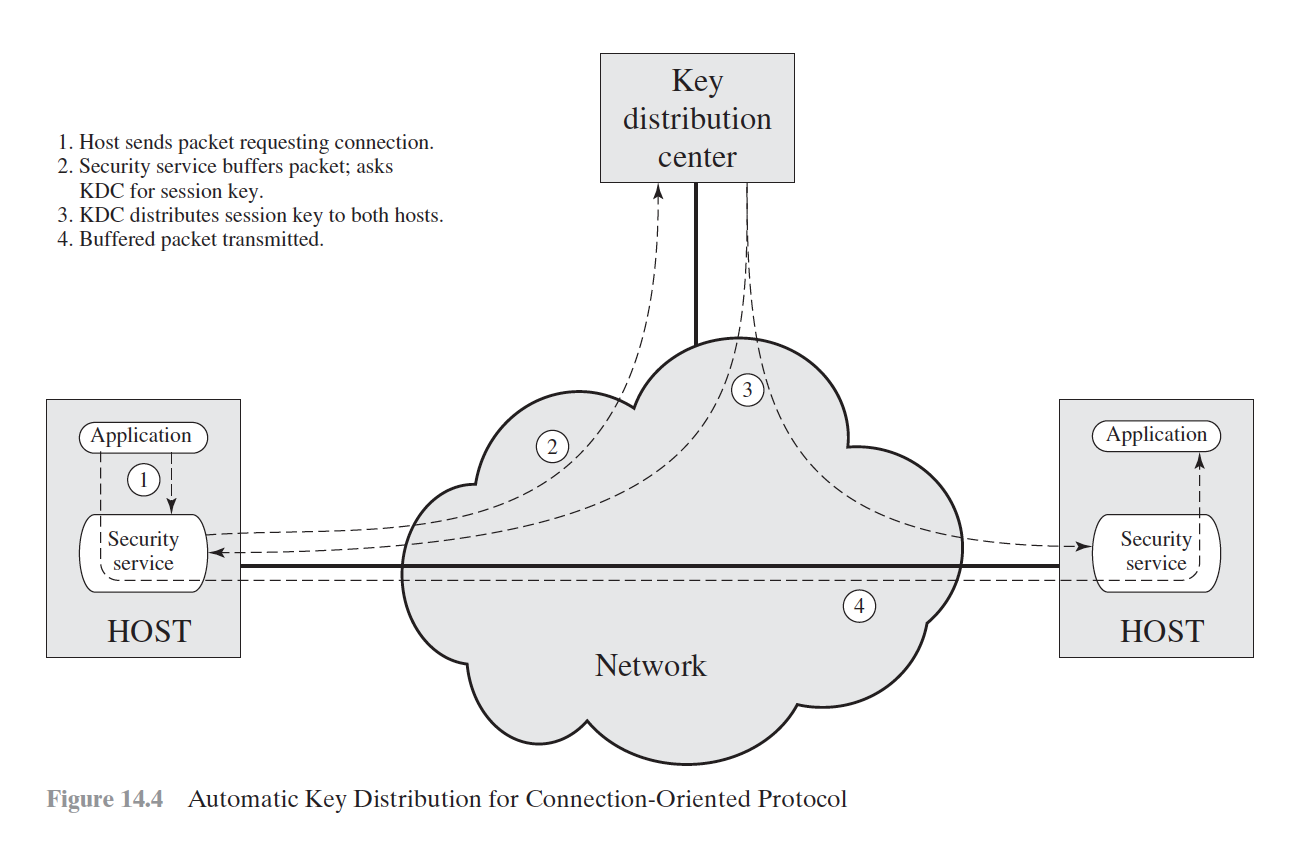
- Host sends packet requesting connection.
- Security service buffers packet; asks KDC for session key.
- KDC distributes session key to both hosts.
- Buffered packet transmitted.

Decentralized Key Control
- Discourages the use of KDC
- Useful within a local context
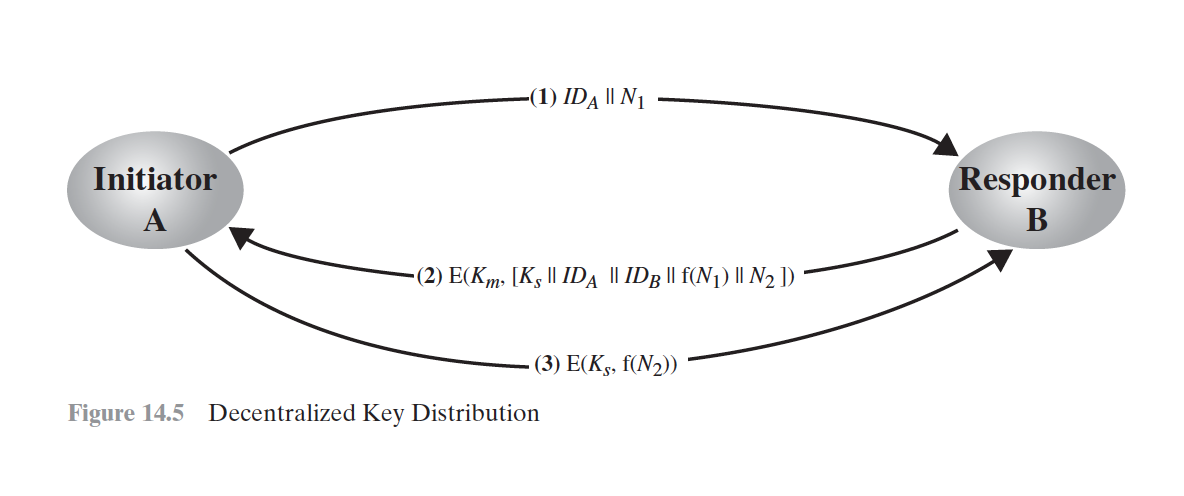

Controlling Key Usage
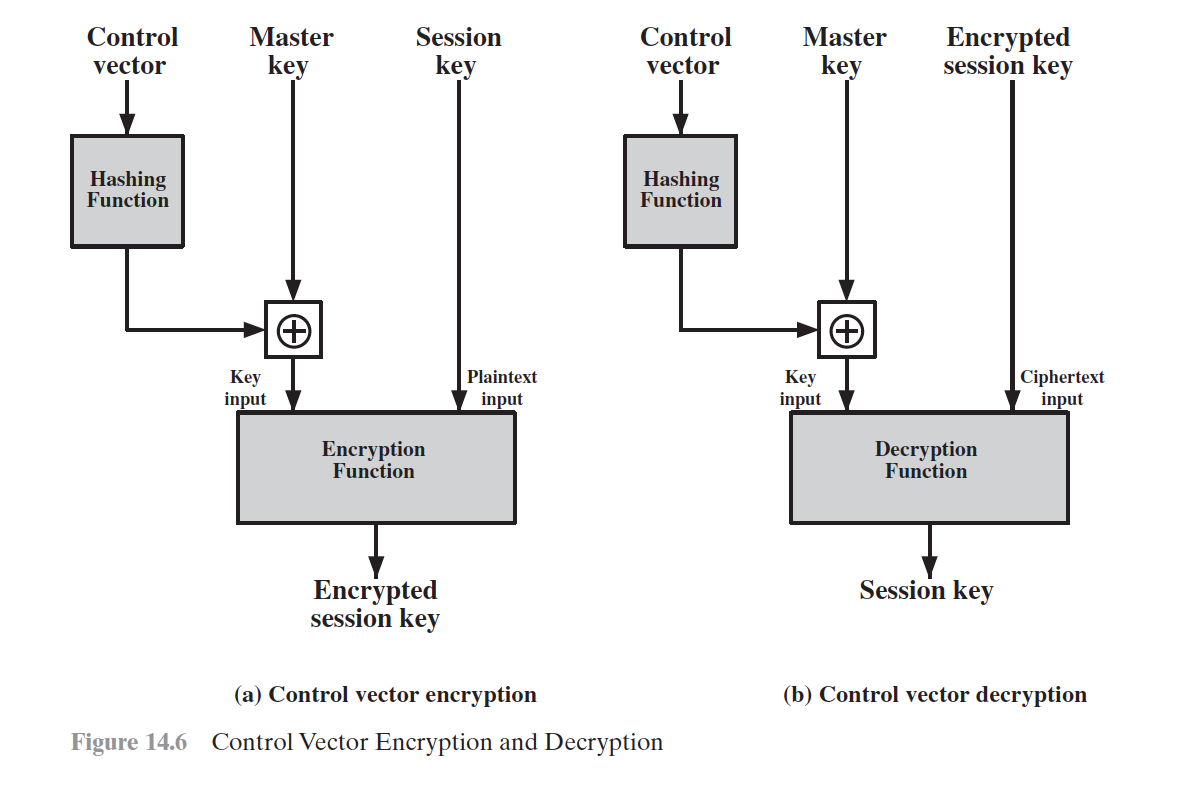

Symmetric Key Distribution using asymmetric encryptions
- Simple Secret Key Distribution
- Secret Key Distribution with Confidentiality and Authentication
- A Hybrid Scheme
Simple Secret Key Distribution



MITM Attack


Secret Key Distribution with Confidentiality and Authentication
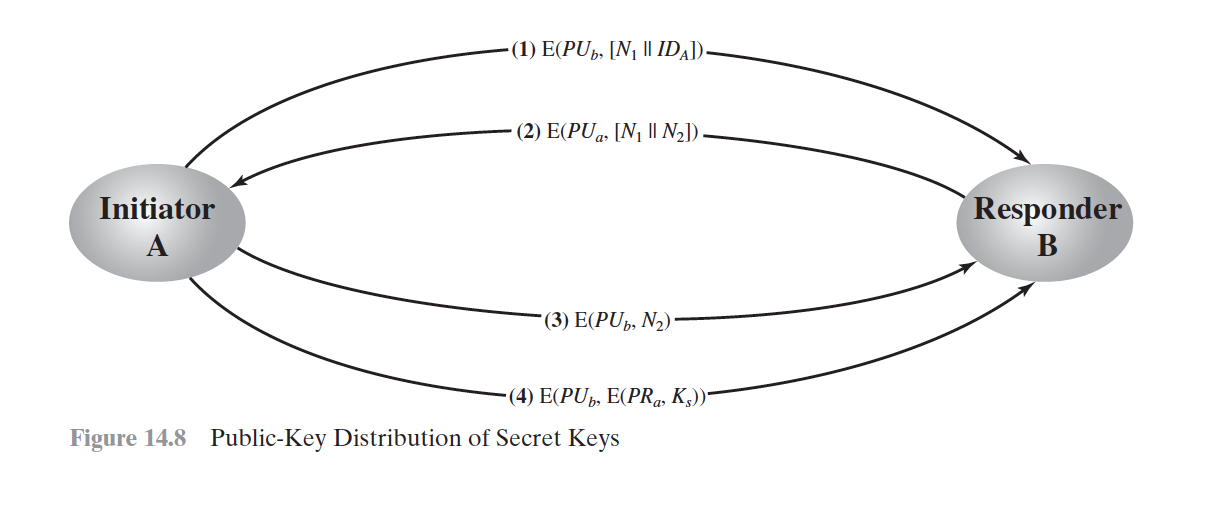

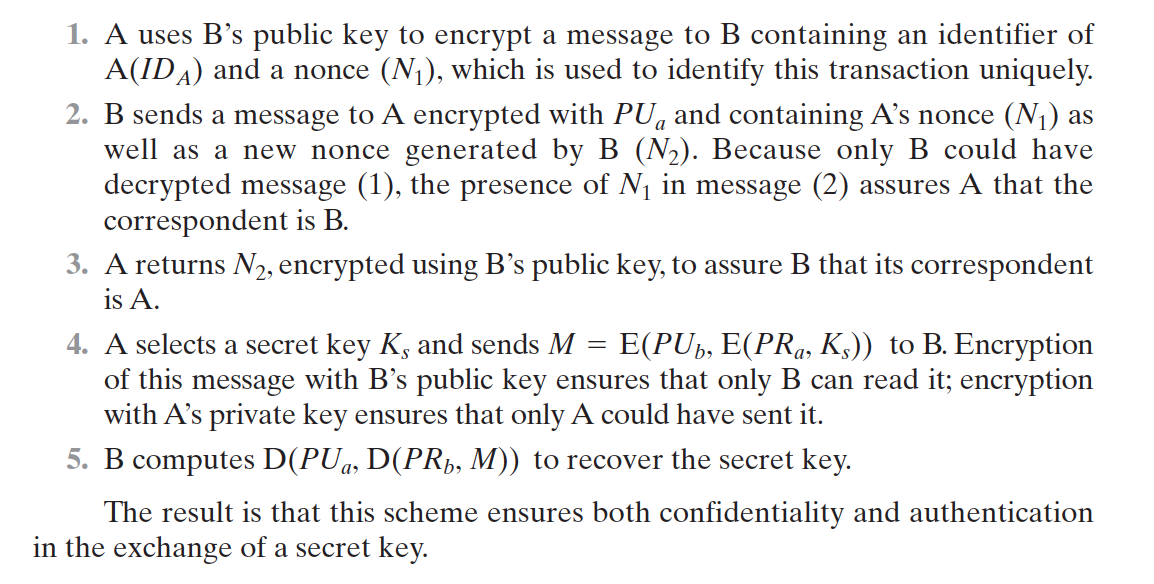
A Hybrid Scheme
- Performance
- Backward Compatibility
DISTRIBUTION OF PUBLIC KEYS
DISTRIBUTION OF PUBLIC KEYS
• Public announcement • Publicly available directory • Public-key authority • Public-key certificates
Public announcement
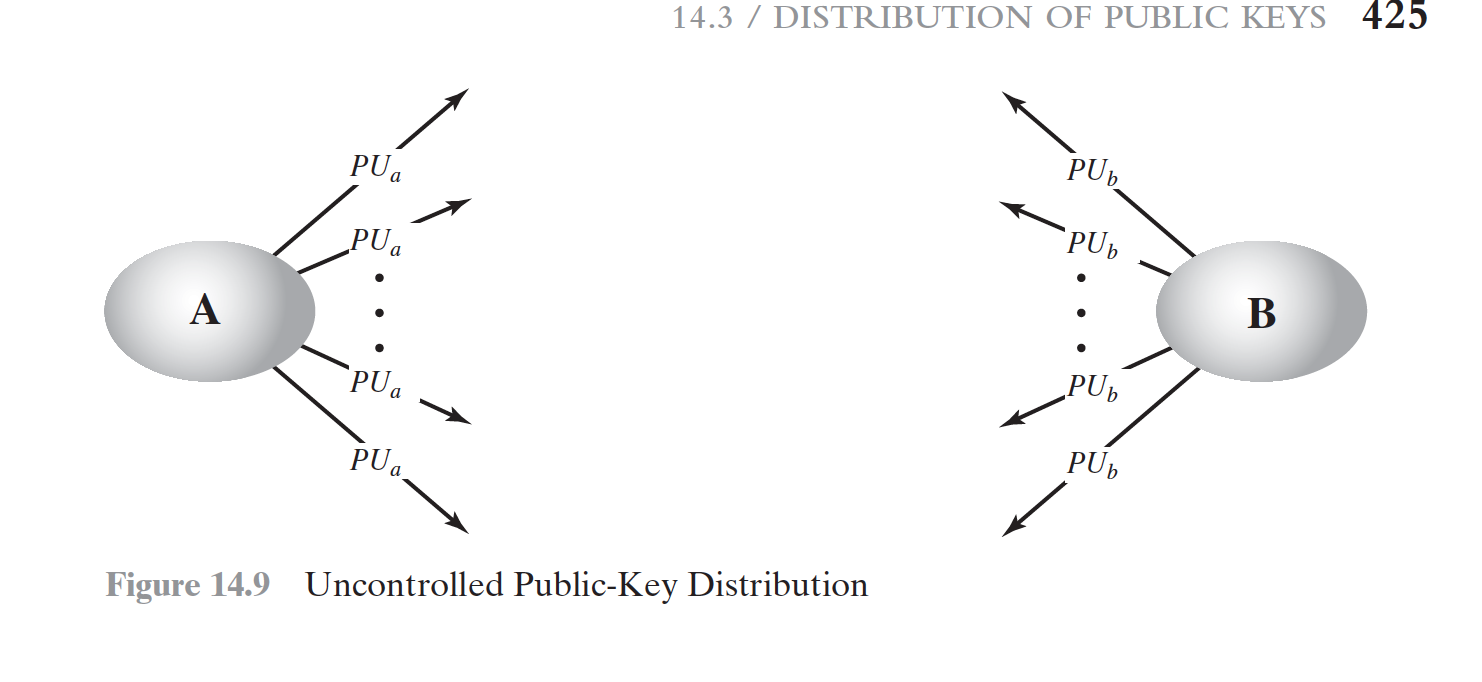

Publicly available directory
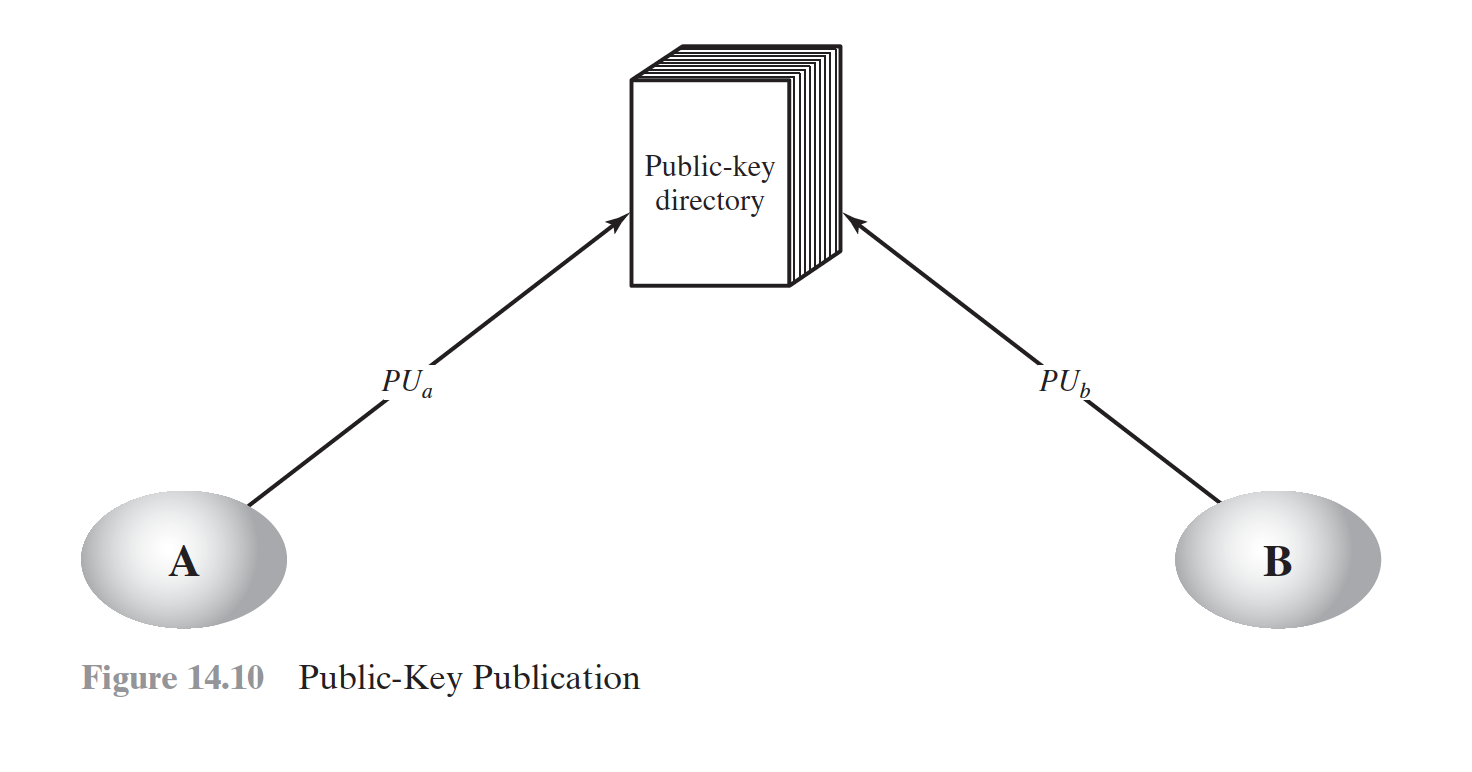

Public-key authority


Public-key certificates
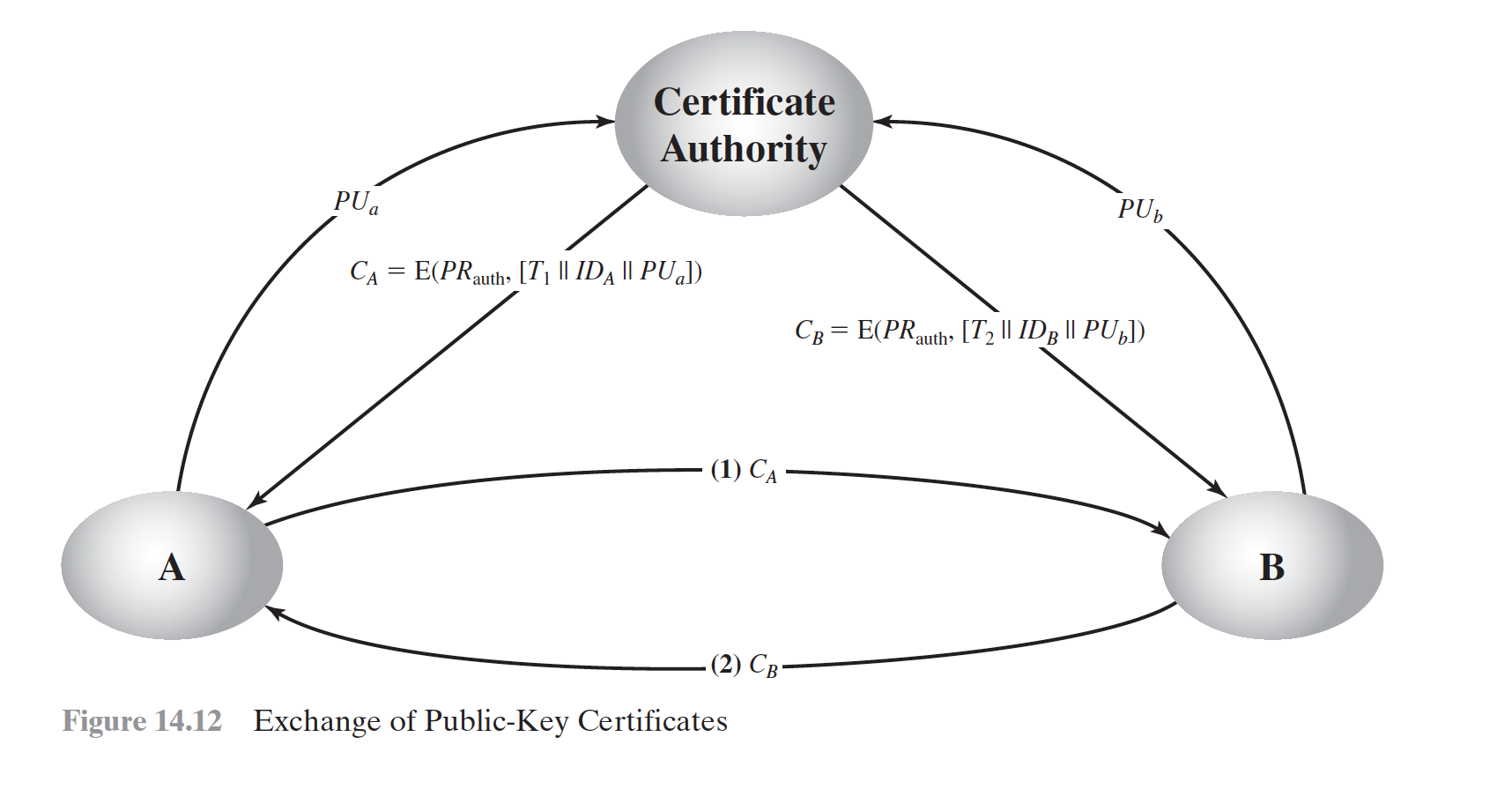

X.509 Certificates
- 1988 -> 1990 -> 1993 -> 1995 ->2000
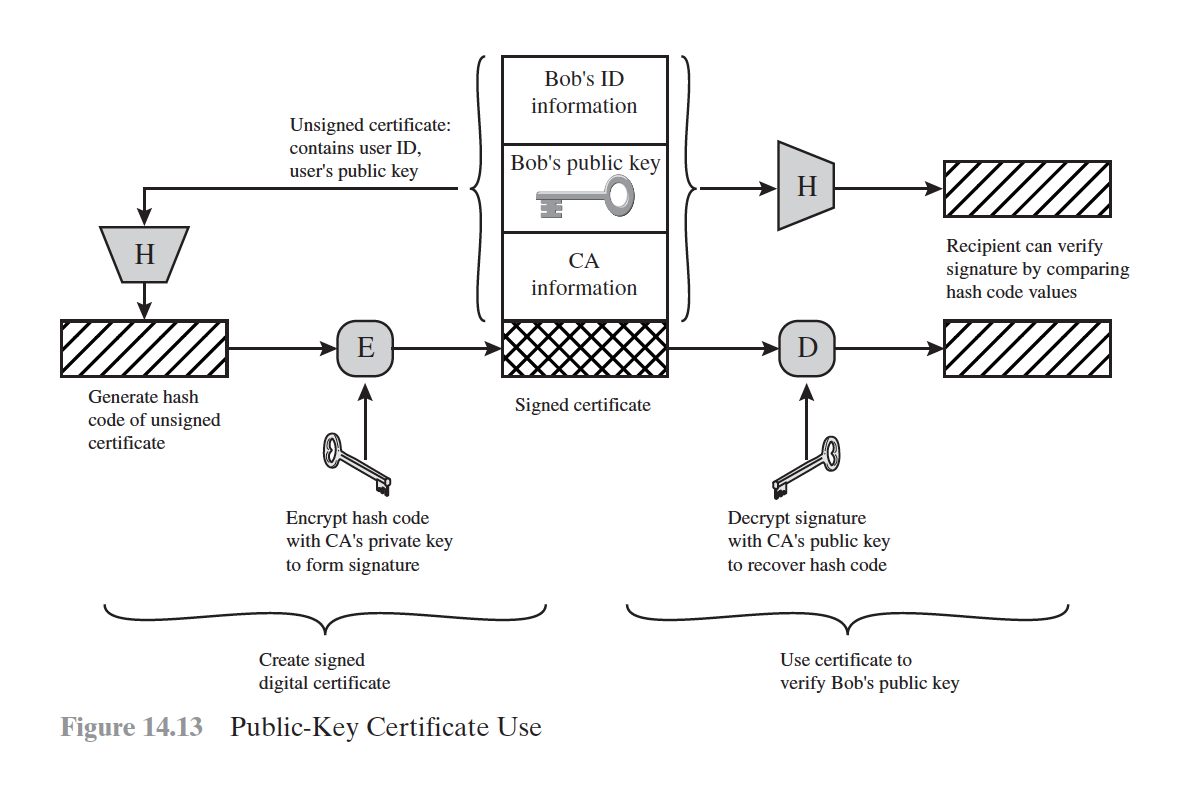
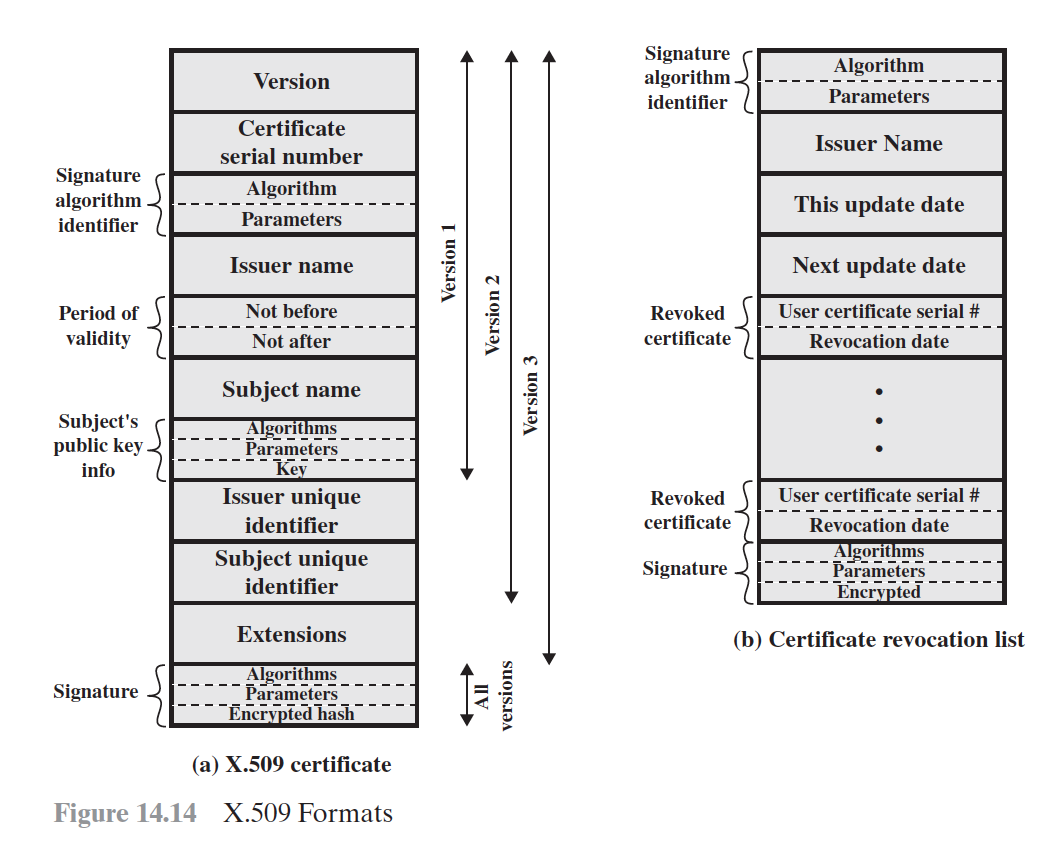
PUBLIC-KEY INFRASTRUCTURE
- PKIX Architectural Model
- Elements of PKIX Architectural Model
- PKIX Management Functions
PKIX Architectural Model
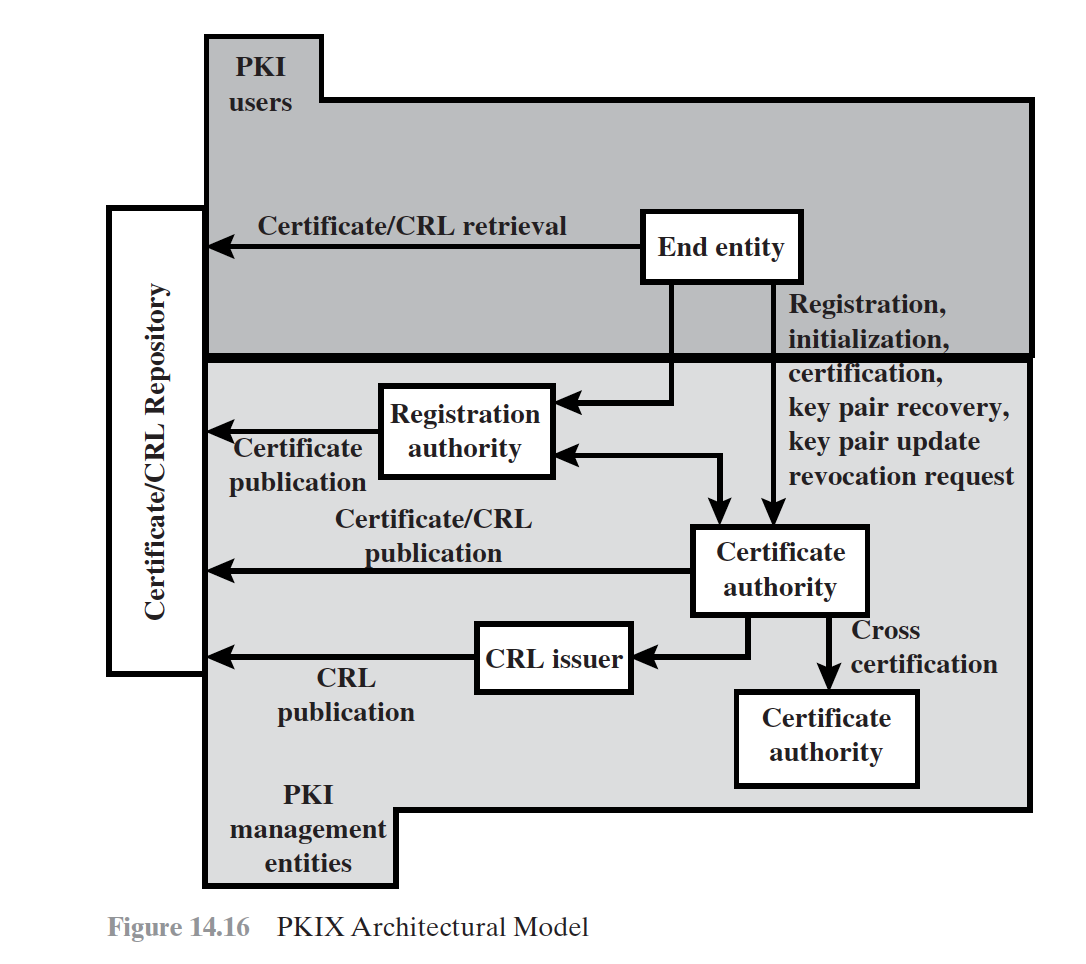
Elements of PKIX Architectural Model
- End entity
- Certification authority (CA)
- Registration authority (RA)
- CRL issuer
- Repository
PKIX Management Functions
- Registration
- Initialization
- Certification
- Key pair recovery
- Key pair update
- Revocation request
- Cross certification